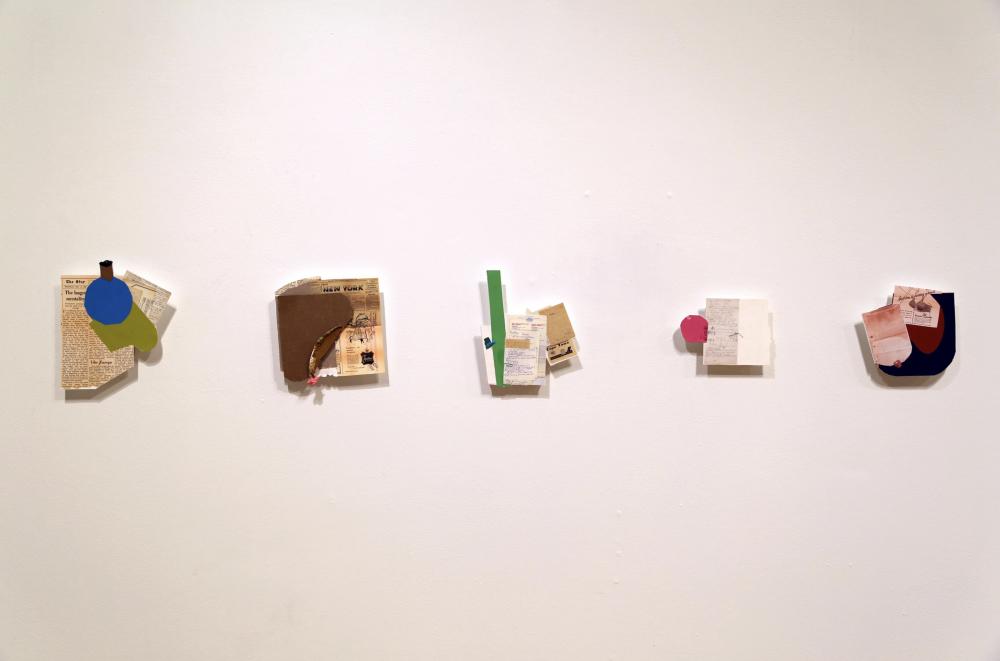You can tell from the title that “Clippings, Voids and Banana Curry” is going to be fun. On view through December 9 at Washington College’s Kohl Gallery, it brings together the work of Jo Smail and Paul Jeanes, two artists from very different backgrounds, who became friends when both were teaching at Maryland Institute College of Art.
At first, it seems to be an odd pairing. Jeanes’s large, powerful paintings unquestionably dominate the gallery with their stark black-and-white slanting shapes, but it’s Smail’s tiny collages that will draw you in like magnets. Shortly, you almost forget about Jeanes as you slip into reading the ’50’s and ’60’s vintage recipes, smiling at the ads for outmoded ladies’ undergarments, and shaking your head at the strangely polite newspaper articles on issues surrounding apartheid.
Smail was born and raised in South Africa, and when she brought a bag full of her mother’s old recipes (including one for banana curry) home from a recent visit, she discovered articles and ads on the back of some of the recipes clipped from newspapers that stand as cultural artifacts of the country during its apartheid years.
Although Smail is primarily an abstract painter, she layered scans of the clippings along with many handwritten recipes and old envelopes into playful compositions of understated color and texture. Floating an inch or so from the wall, these dozens of collages seem to dance, one after another, across the walls of the gallery in a collection hovering between nostalgia and immediacy. Simultaneously engaging and edgy, they call to mind a time when cheerful Afrikaner women, in dresses tailored to the latest American pointy bras and waist-trimming foundation garments, ostensibly found fulfillment in whipping up new recipes every day, while blissfully ignoring the race-based poverty outside their kitchen doors.
Unframed and eschewing the usual rectangular format, Smail’s collages take their complicated shapes from the multiple angles of the clippings, punctuated here and there with offhand painted shapes. Sometimes gestural, sometimes almost evoking an object (one resembles a cartoon time bomb), these painterly elements nimbly introduce a certain animating awkwardness, possibly a metaphor for the deep flaws in the prim culture evoked by the clippings. Casual and often comical, her collages hum with a portentous tension not unlike that underlying our own times.
Curiously, Jeanes’s paintings and inkjet prints possess a similar bracing tension, though it reverberates more in the body than the mind. Jeanes teases optical quandaries by playing mercilessly with perspective. What our eyes want to interpret as the four panes of a window in “Project Painting #3” just won’t quite come together. The edges of the “panes” tilt in irreconcilable directions and don’t quite line up. Sometimes, they even shift directions as if bending back or forward. It’s a visual conundrum that both fascinates and sets your teeth on edge.
To complicate matters further, there’s a creeping realization that super-subtle angled shapes deriving from nothing more than a change in the sheen of the black paint float behind the white shapes. As you grow attuned to these nuances, you begin to notice that the empty white “panes” are not voids, but are alive with evidence of underpainting mingled with the woven texture of the underlying linen panel. A weird sensation of physicality vies with the painting’s tense geometry as the very idea of illusory space held within a static picture plane dissolves.
In his inkjet prints, Jeanes hints that his process begins with observations of actual objects or places. There’s no telling what they really are (a theater stage? a book? a sunbeam slanting across a floor?), but he photographs phenomena that interest him then prints them and cuts them up, rearranges them, experiments, and finally, projects them onto linen or canvas to create his final paintings. Unlike Smail, he prefers his sources to remain anonymous, and he works on a large enough scale that you feel like you could walk into one of his paintings and be lost in an hallucinatory world of shifting perspectives.
More than 30 years her junior and with less exotic roots in North Carolina, Jeanes nonetheless approaches the creative process with the same open, exploratory spirit that Smail cultivates. Curiosity and playful humor energize both artists’ works and make them fun to look at, but it’s the tension of incompatible viewpoints that keep them loitering in the mind. The impossibility of the coexistence of privilege and equality summoned by Smail’s collages and the irreconcilable viewpoints implied by Jeanes’s paintings prod and probe at our settled understandings of the world we live in.
Mary McCoy is an artist and writer who has the good fortune to live beside an old steamboat wharf on the Chester River. She is a former art critic for the Washington Post and several art publications. She enjoys the kayaking the river and walking her family farm where she collects ideas and materials for the environmental art she creates, often in collaboration with her husband Howard. They have exhibited their work in the U.S., Ireland, Wales and New Zealand.





Write a Letter to the Editor on this Article
We encourage readers to offer their point of view on this article by submitting the following form. Editing is sometimes necessary and is done at the discretion of the editorial staff.